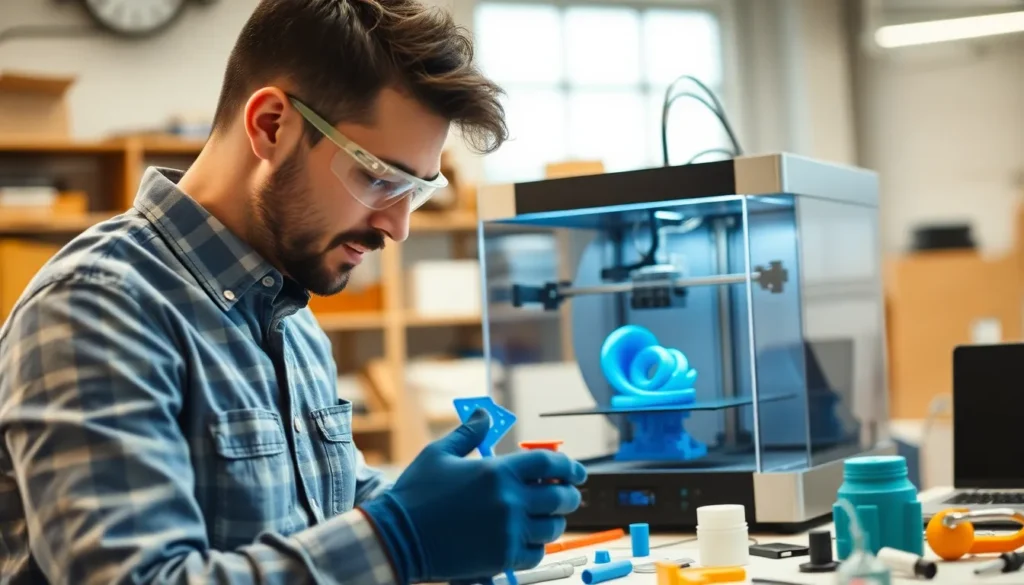Table of Contents
ToggleIn a world where creativity knows no bounds, 3D printing stands out as the ultimate game-changer. Imagine a technology that can turn your wildest ideas into tangible reality—yes, it’s like magic but with a lot less wand-waving. From quirky prototypes to life-saving medical devices, 3D printing is revolutionizing industries at lightning speed.
But don’t just take their word for it. Dive into the fascinating realm of 3D printing case studies, where innovation meets inspiration. These real-world examples showcase how businesses and individuals are harnessing this technology to solve problems, cut costs, and even save the planet. Buckle up and get ready to explore some of the most jaw-dropping success stories that prove 3D printing isn’t just a trend; it’s a transformative force shaping our future.
Overview of 3D Printing
3D printing, known technically as additive manufacturing, enables the creation of three-dimensional objects by layering materials. This innovative technology utilizes computer-aided design (CAD) models to transform digital blueprints into tangible products. Various materials, such as plastics, metals, and ceramics, serve as inputs for this process, making it highly flexible across industries.
Industries leveraging 3D printing include aerospace, automotive, and healthcare. In aerospace, manufacturers create lightweight parts that enhance fuel efficiency, while automotive companies streamline prototyping processes. Healthcare benefits significantly through the development of customized prosthetics and implants, tailored to individual patient needs.
Cost reduction emerges as a notable advantage of 3D printing. Traditional manufacturing often incurs high costs due to tooling and machining. With 3D printing, companies minimize these expenses by producing parts directly from digital files, which decreases material waste and shortens production timelines.
Sustainability represents another crucial aspect of 3D printing. The technology contributes to environmental conservation by using only the necessary amount of material for production, reducing excess waste. In addition, local production capabilities decrease transportation emissions, promoting a more sustainable manufacturing model.
Success stories highlight the effectiveness of 3D printing across various sectors. Companies report shorter lead times and enhanced design capabilities. As industries adapt to this technology, they continually discover new applications, signifying an ongoing evolution that reshapes traditional manufacturing methods.
Key Industries Utilizing 3D Printing Case Studies
3D printing plays a critical role across various industries. Each sector showcases unique innovations and applications, demonstrating the technology’s versatility and importance.
Healthcare Innovations
Healthcare utilizes 3D printing to create customized prosthetics and medical devices. Surgeons rely on 3D-printed models for accurate pre-surgical planning and simulations. The technology allows for the production of patient-specific implants, enhancing treatment outcomes. Hospitals report reduced manufacturing times for tailored solutions, enabling quicker patient care. Notable advancements include bioprinting organs and tissues, which could revolutionize transplant procedures in the future.
Automotive Applications
Automotive companies adopt 3D printing for rapid prototyping and production of complex parts. The ability to design lightweight components results in improved vehicle efficiency. Manufacturers benefit from reduced lead times, allowing for faster innovation cycles. Customization options cater to specific vehicle designs, promoting unique features. Companies like Ford and BMW utilize 3D printing for in-house production, resulting in significant cost savings and waste reduction.
Aerospace Developments
Aerospace relies on 3D printing to produce lightweight, durable components for aircraft. The capability to manufacture complex geometries leads to enhanced performance and fuel efficiency. Organizations such as Boeing and Airbus harness this technology to reduce parts inventory and streamline supply chains. Rapid prototyping accelerates the development process, allowing faster regulatory approvals. Additionally, 3D printing supports on-demand manufacturing, minimizing the need for extensive warehousing.
Success Stories in 3D Printing
3D printing significantly transforms product development and customization across industries. Below are key examples showcasing its impact.
Product Development and Prototyping
Companies increasingly adopt 3D printing for rapid prototyping, reducing development time. For instance, Ford utilizes this technology to create complex component designs faster, enabling quicker market entry. Adidas leverages 3D printing to design innovative footwear, allowing for real-time adjustments based on feedback. Significant cost savings occur due to decreased material waste and simplified supply chains. Both of these examples highlight how 3D printing streamlines the prototyping process while enhancing creativity.
Customization and Personalization
3D printing excels in delivering personalized products tailored to individual needs. For example, Align Technology produces custom Invisalign clear aligners using this technology, ensuring each patient receives a perfect fit. Additionally, companies like Shapeways allow consumers to design unique items, from jewelry to home décor. Clothing brands also explore personalized fashion, with 3D-printed accessories enhancing customer experiences. These applications demonstrate how customization through 3D printing meets specific consumer demands efficiently.
Challenges Faced in 3D Printing Case Studies
Several challenges arise in 3D printing case studies that impact effectiveness and efficiency. Addressing these challenges can significantly enhance outcomes across various applications.
Technical Limitations
Technical limitations hinder 3D printing adoption in specific contexts. The speed of production often varies, making it difficult to meet tight deadlines. Precision issues may affect the integrity of complex designs, resulting in parts that do not fit as intended. Layer adhesion problems can create weak bonds within prints, compromising overall strength. Furthermore, limited build sizes restrict the production of larger components. These technical constraints necessitate ongoing research and development to optimize processes and expand capabilities in the field.
Material Challenges
Material challenges present significant barriers in 3D printing. Not all materials offer compatibility with every printer type, limiting versatility in production. Some materials lack required properties, such as strength or flexibility, which can impede their functionality in applications. Variability in material quality may lead to inconsistent results, affecting overall reliability. Additionally, the cost of high-performance materials often restricts their use to specialized projects. Overcoming these material challenges is essential for unlocking the full potential of 3D printing across industries.
Future Trends in 3D Printing
Emerging trends in 3D printing shape its future across various sectors. Increased material diversity enhances capabilities and applications, with research into new substances like bio-based plastics and metal alloys. Customization will continue to drive consumer interest, as 3D printing technology fosters unique designs tailored to individual needs.
Automation also plays a crucial role in scalability, integrating artificial intelligence and machine learning to optimize production processes. Streamlined workflows can result in faster turnaround times and improved precision. Moreover, software advancements support enhanced design tools, allowing users to create intricate models with ease.
Sustainability remains a priority as industries seek greener manufacturing methods. Techniques that reduce waste and energy consumption are becoming increasingly important. Adoption of local production methods cuts down transportation emissions and supports regional economies.
Healthcare innovations illustrate how 3D printing transforms patient care. Personalized treatments and medical devices, such as implants and prosthetics, cater to specific patient needs, improving outcomes. Development in bioprinting holds promise for tissue and organ regeneration, revolutionizing transplantation practices.
Automotive advancements focus on lightweight parts that enhance fuel efficiency and performance. Manufacturers increasingly rely on 3D printing for rapid prototyping, allowing for quicker iteration and refinement of designs. Aerospace applications demonstrate the potential for complex geometries and materials, achieving significant weight savings.
Evaluating these trends highlights the ongoing evolution within 3D printing technology. Industries leveraging this innovation will witness adaptability and responsiveness to consumer demands. Continuous exploration of new applications and materials solidifies the significance of 3D printing as a foundational technology in various fields.
Conclusion
The impact of 3D printing extends far beyond mere novelty. Its ability to innovate and streamline processes across various industries is undeniable. As businesses continue to adopt this technology, they not only enhance efficiency but also pave the way for sustainable practices.
The challenges faced in 3D printing are substantial yet surmountable with ongoing research and development. The future looks promising with advancements in materials and automation.
Ultimately, 3D printing stands as a testament to human creativity and ingenuity, driving significant changes in manufacturing and design. Its role in shaping the future of production and customization is set to grow even stronger, making it a vital component of modern industry.




